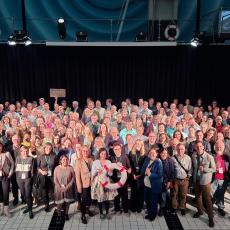A leak from a rare-earth mine threatens villages in northern Laos
This piece was first published by Asia Democracy Chronicles. Photo: by Lamxay Duangchan, Asia Democracy Chronicles )
Vanh had not known about the massive fish kills further upstream, as well as cows dropping dead after drinking from the river. But then their village chief began to go around to tell everyone what had been happening in other communities up the mountain, and for them to stop using water from the river.
That was last March. When Asia Democracy Chronicles (ADC) visited Vanh’s village two months later, in Laos’s northern province of Houaphanh, the mother of five had still not resumed fishing in the Vane River, just a few steps from her house. Neither was she getting water from it for her vegetable garden or for the rest of her household.
By then, Radio Free Asia had already run a report quoting a district official that water from the Vane River was now “safe for growing rice,” and that the results of tests done in different spots in the river proved that its water was no longer hazardous.
But Vanh, who preferred to be identified using a pseudonym for this story, was not about to take any chances. A fellow villager agreed with Vanh’s decision. With an infant on her hip, the villager said that she was worried that the rivers still had chemicals that could be unsafe for her child and the rest of her family.
“I can’t wash my baby’s cotton diapers and my own clothes with the water because I am scared of it,” she said. “I resort to the rainwater and the water that is pumped from the mountain. We have to use this for washing household utensils and cleaning food and vegetables or showering.”
Last Feb. 22, large volumes of contaminated water from the Laos-China Rare Mineral Development Company North 2 Ltd., operating in the remote mountain village of Thap Peng in Houaphanh, somehow wound up in local tributaries, as well as in the 325-km Nam Sam River that connects with Vietnam’s Song Ma River.
No one outside of the mining company knew about the mishap until the fish started turning up dead in the rivers near the site, and people began to fall ill. Yet even then, it took growing complaints posted by locals on social media before provincial officials began to look into the incident.
An investigation carried out by the Ministry of Energy and Mines revealed that not only was there runoff of tainted water used during the mining process, there had also been a leak from a chemical storage tank. The leaked substances included heavy metal chemicals, such as cyanide, arsenic, and lead.
Hundreds of families in the 36 affected villages have since pleaded with the Lao government to provide assistance and cancel the mining activities altogether. But aside from villages downstream receiving money to help them buy food, official action on the matter seems to have stopped at producing the investigation report and government as well as company representatives meeting with leaders of select villages. So far, too, there has been no news about when a promised rockfill dam will be built to prevent similar mishaps.
But then that is no surprise in a country where the state always comes first, and the people are rarely consulted – if at all. This is especially true in remote areas, where many ethnic minorities reside.
According to the chief of Vanh’s village, they were not even informed about the rare-earth mining project high up the mountain, as there was never any invitation to attend or notification to his community about a public hearing about the construction of the mining site.
“Neither I nor the people in my village were informed about the project because our village is downstream, while the mining site is upstream,” he told ADC. “As a downstream community, we are the most affected by this project. We need the company, the government, and the authorities to look after us and ensure that we can use our river safely again.”
A major joint venture
Officials of the company, a joint venture between Lao and Chinese state firms, could not be reached by ADC for comment.
Begun in 2022, the rare-earth mining project in Houaphanh is among the largest of its kind in the country. Beijing Platinum World Technology Development put up 55 percent or over US$21 million of the total investment in the project, which covers 197.88 sq km (approximately 19,778 hectares, or 158,224 Olympic swimming pools). Phadang Hungheuang Huaphan Mining Sole Company, ບໍລິສັດ ຜາແດງຮຸ່ງເຮືອງ ຫົວພັນ ມາຍນິງ ຈຳກັດຜູ້ດຽວ, representing Lao Mining Development State Enterprise (LMD), contributed the remaining 45 percent.
From 2023 to the present, the company has processed 8,860 tons of rare minerals from the Houaphanh site, distributing 7,500 tons valued at over US$50 million, according to the Ministry and Energy and Mines. This represents an unusually fast commencement of mining operations.
Rare earth elements (REE) refer to 15 lanthanides that are incorporated into high-tech and clean-energy products to deliver special properties such as magnetism, luminescence, and strength. They are also used in weapons systems to provide similar properties. The United States Geological Survey (USGS) reports that China controls the global rare-earth mineral market, and is responsible for more than 95 percent of the world’s current supply. But that has led to water and soil pollution in rare-earth mining sites in China, such as in southern Jiangxi province, where cleaning up the toxic mess left by mining here has been estimated to reach US$5.5 billion.
In recent years, Laos has become one of China’s important partners for amassing rare-earth minerals outside of its borders. Last year, Lao Prime Minister Sonexay Siphandone announced that Vientiane would allow investments in rare-earth mining as part of the government’s strategy to boost the country’s foreign exchange reserves and alleviate its economic and financial difficulties. These include paying its growing debt to China, which in 2018 was already estimated to have reached US$12.2 billion.
Interestingly, it was also last year that a legislator from Houaphanh urged the government to halt development plans to have 15 rare-earth mining projects by 2030, citing “environmental and community” impacts.
“Rare earth mining in Houaphanh has caused significant environmental and community damage,” said Khonepaphanh Leuangsychanthong at a July 2023 National Assembly meeting. “The extraction process involves injecting chemicals underground and using water, which raises the risk of chemical leaks. Additionally, mining in high mountainous regions exacerbates these risks.”
He also pointed out that the government lacked clarity on the types and quantities of rare-earth minerals exported from Laos. Moreover, he said, there were no standard selling prices for these minerals, thereby limiting the government's ability to collect taxes, prompting it to rely instead on revenues from granting concessions. This complicates not only trade, but also affects any compensation that locals may be offered for an accident, including chemical contamination of their community.
Water worries continue
Apparently, however, Khonepaphanh’s words fell on deaf ears. Government data show that there are now 21 active rare-earth companies in Laos. Meanwhile, life for villagers like Vanh has gotten harder than before. When ADC met with her, she said that she had to double her efforts to earn more so that she could travel to the nearest city, Sam Neua, and buy food.
“I am unsure about the safety of the water now,” said Vanh, who weaves to augment the family income that comes mainly from farming. “It used to be a food source, feeding everyone here, but now it is contaminated with chemicals. Vegetables cannot be grown and fish cannot be eaten like they used to be. My life is not as good as it used to be when the water was clean. This river has been everything to our village.”
Farther up, in a Hmong village hidden deep in the mountains, two women shared tea while expressing their concerns about the rare-earth mining near their water source uphill.
Said one of the Hmong women: “After learning that chemicals from the mining site have killed fish and caused severe injuries to people exposed to the contaminated water, we no longer want to fish in the nearby rivers or eat fish from those streams.”
The mining site itself is so remote that reaching it from Sam Neua requires about seven hours of travel along gravel roads, mountainous motorbike trails, and through quiet forests. The route is not available on online maps and navigable only by motorbikes and reliance on directions from locals, who speak little Lao and often resort to hand signals to indicate turns.
New dirt roads have been carved through diverse mountain communities to facilitate the transport of rare earth minerals and the movement of heavy machinery to extraction sites. Nearby, camps housing Chinese workers are visible, not far from the bustling mining operations.
ADC chanced upon another group of young women, this time from the Phong (ເຜົ່າຜ້ອງ), one of Laos's smallest northern ethnic groups. They said their husbands work as seasonal employees for the rare-earth mining company during the dry season.
They were worried about their husbands’ safety, they said, as well as about the chemicals from the mining site contaminating the nearest water stream. As a result, the women said that they have had to find water sources much farther from their homes.
“Who wouldn’t be afraid of chemicals?” asked one of the women. “But we have no choice but to live with them now. We lack the resources to pump groundwater for daily use since we have no electricity. Our village only has temporary power at night for lighting. I don’t really understand what rare-earth mining is, because I don't speak Lao well. I only know the Phong language."
Association Area 4 (ສະມາຄົມເຂດ 4), a local non-profit advocacy group, has been trying to have the affected communities’ concerns reach the wider Lao public. The group recently noted an improvement in water conditions with the onset of the rainy season, which has diluted the chemical concentrations.
A member of the group also said, “To mitigate the current impact, we can cultivate plants such as water hyacinths to help absorb the chemical pollutants that have been present for a while. Despite this, it's uncertain if the water will become safe, as these chemicals could persist for decades.”
Houaphanh may also be hosting another rare-earth mining concern soon, too.
ChiJin Laos, a subsidiary of Chifeng Gold (the majority shareholder in one of the largest gold mining companies in Laos), is planning to mine rare earth minerals there. Together with LMD, ChiJin Laos has already completed exploration of its target areas in Houaphanh.



